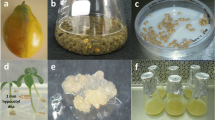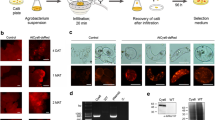Abstract
A method for the genetic transformation of several citrus cultivars is described, including cultivars observed to be recalcitrant to conventional epicotyl-mediated transformation. Embryogenic cell suspension cultures, established from unfertilized ovules were used as target tissues for Agrobacterium-mediated transformation. Several modifications were made to the culture environment to investigate factors required for efficient transfer of the T-DNA and the subsequent regeneration of transgenic citrus plants. It was determined that co-cultivation of citrus cells and Agrobacterium in EME medium supplemented with maltose (EME-M) and 100 μM acetosyringone for 5 days at 25°C was optimum for transformation of each of the citrus cultivars. Efficient selection was obtained and escapes were prevented when the antibiotic hygromycin B was used as a selection antibiotic following transformation with an Agrobacterium strain containing hptII in the T-DNA region. Transgenic embryo regeneration and development was enhanced in medium that contained a liquid overlay consisting of a 1:2 mixture of 0.6 M BH3 and 0.15 M EME-M media. PCR and Southern blot analyses confirmed the presence of the T-DNA and the stable integration into the genome of regenerated plants, while RT-PCR demonstrated variable amounts of RNA being transcribed in different transgenic lines. This protocol can create an avenue for insertion of useful traits into any polyembryonic citrus cultivar that can be established as embryogenic cell suspension cultures, including popular specialty mandarins and seedless cultivars.









Similar content being viewed by others
Abbreviations
- BAP:
-
6-Benzylaminopurine
- EGFP:
-
Enhanced green fluorescent protein
- hptII:
-
Hygromycin phosphotransferase gene
- MES:
-
2-(N-morpholino)ethane sulfonic acid
- MS:
-
Murashige and Skoog medium
- NAA:
-
Naphthaleneacetic acid
- nptII:
-
Neomycin phosphotransferase gene
- YEP:
-
Yeast extract peptone
References
Angenon G, Dillen W, Van Montagu M (1994) Antibiotic resistance markers for plant transformation. In: Gelvin SB, Schilperoort RA (eds) Plant molecular biology manual. Kluwer, Dordrecht, pp 1–13
Attree SM, Pomeroy MK, Fowke LC (1992) Manipulation of conditions for the culture of somatic embryos of white spruce for improved triacylglycerol biosynthesis and desiccation tolerance. Planta 187:395–404
Ben-Hayyim G, Neumann H (1983) Stimulatory effect of glycerol on growth and somatic embryogenesis in citrus callus cultures. Z Pflanzenphysiol 110:331–337
Brisibe EA, Miyake H, Taniguchi T, Maeda E (1994) Abscisic acid and high osmoticum regulation of development and storage reserve accumulation in sugarcane somatic embryos. Jpn J Crop Sci 63:689–698
Burrow MD, Chlan CA, Sen P, Murai N (1990) High frequency generation of transgenic tobacco plants after modified leaf disk co-cultivation with Agrobacterium tumefaciens. Plant Mol Biol Rep 8:124–139
Cabasson C, Alvard D, Dambier D, Ollitrault P, Teisson C (1997) Improvement of Citrus somatic embryo development by temporary immersion. Plant Cell Tiss Org Cult 50:33–37
Cervera M, Pina JA, Juarez J, Navarro L, Pena L (1998) Agrobacterium mediated transformation of citrange: factors affecting transformation and regeneration. Plant Cell Rep 18:271–278
Domínguez A, Cervera M, Pérez RM, Romero J, Fagoaga C, Cubero J, López MM, Juárez JA, Navarro L, Peña L (2004) Characterization of regenerants obtained under selective conditions after Agrobacterium-mediated transformation of citrus explants reveals production of silenced and chimeric plants at unexpected high frequencies. Mol Breed 14:171–183
Dutt M, Grosser J (2009) Evaluation of parameters affecting Agrobacterium-mediated transformation of citrus. Plant Cell Tiss Org Cult 98:331–340
Dutt M, Orbovic V, Grosser JW (2009) Cultivar dependent gene transfer into citrus using Agrobacterium. Proc Fla State Hortic Soc 122:85–89
Dutt M, Madhavaraj J, Grosser JW (2010a) Agrobacterium tumefaciens-mediated genetic transformation and plant regeneration from a complex tetraploid hybrid citrus rootstock. Sci Hortic 123:454–458
Dutt M, Vasconcellos M, Song K, Gmitter F, Grosser JW (2010b) In vitro production of autotetraploid Ponkan mandarin (Citrus reticulata Blanco) using cell suspension cultures. Euphytica 173:235–242
Etienne H, Sotta B, Montoro P, Miginiac E, Carron MP (1993) Relation between exogenous growth regulators and endogenous indole-3-acetic acid and abscisic acid in the expression of somatic embryogenesis in Hevea brasiliensis (Müll. Arg). Plant Sci 88:91–96
Finkelstein RR, Crouch ML (1986) Rapeseed embryo development in culture on high osmoticum is similar to that in seeds. Plant Physiol 81:907–912
Fujii JAA, Slade D, Olsen R, Ruzin SE, Redenbaugh K (1990) Alfalfa somatic embryo maturation and conversion to plants. Plant Sci 72:93–100
Gavish H, Vardi A, Fluhr R (1991) Extracellular proteins and early embryo development in Citrus nucellar cell cultures. Physiol Plant 82:606–616
Gavish H, Vardi A, Fluhr R (1992) Suppression of somatic embryogenesis in Citrus cell cultures by extracellular proteins. Planta 186:511–517
Grosser JW, Chandler JL (2004) Production of twelve new allotetraploid somatic hybrid citrus breeding parents with emphasis on late maturity and cold-hardiness. J Amer Pomol Soc 58:21–28
Grosser JW, Gmitter FG Jr (1990a) Protoplast fusion and citrus improvement. Plant Breed Rev 8:339–374
Grosser JW, Gmitter FG Jr (1990b) Wide-hybridization of Citrus via protoplast fusion: progress, strategies, and limitations. In: Bennet AB, O’Neill SD (eds) Horticultural biotechnology, plant biology, vol 25. Wiley-Liss, New York, pp 31–41
Grosser JW, Gmitter FG, Louzada ES, Chandler JL (1992) Production of somatic hybrid and autotetraploid breeding parents for seedless citrus development. HortScience 27:1125–1127
Grosser JW, Ollitrault P, Olivares-Fuster O (2000) Somatic hybridization in Citrus: an effective tool to facilitate variety improvement. In Vitro Cell Dev Biol-Plant 36:434–449
Grosser JW, Graham JH, McCoy CW, Hoyte A, Rubio HM, Bright DB, Chandler JL (2003) Development of ‘‘tetrazyg’’ rootstocks tolerant of the diaprepes/phytophthora complex under greenhouse conditions. Proc Fla State Hortic Soc 116:262–267
Haccius B (1978) Question of unicellular origin of non-zygotic embryos in callus cultures. Phytomorphology 28(1):74–81
Han SH, Ahn HJ, Kang SK, Kim HY (2005) Expression of green fluorescent protein gene in the callus of Satsuma mandarin (Citrus unshiu cv. Miyagawa Wase) by Agrobacterium-mediated transformation. J Korean Soc Hortic Sci 46(1):39–42
Hansen G, Wright MS (1999) Recent advances in the transformation of plants. Trends Plant Sci 4:226–232
Hood EE, Gelvin SB, Melchers LS, Hoekema A (1993) New Agrobacterium helper plasmids for gene transfer to plants. Transgenic Res 2:208–218
Huang Y, Stokke DD, Diner AM, Barnes WM, Karnosky DF (1993) Virulence of Agrobacterium on Larix deciduas and their cellular interactions as depicted by scanning electron microscopy. J Exp Bot 44:1191–1201
Jiménez VM, Guevara E (1995) Regeneración in vitro mediante embriogénesis somática de variedades de cítricos. I. Obtención de callo friable y suspensiones celulares de naranja dulce (Citrus sinensis) y naranja agria (Citrus aurantium) cultivadas en Costa Rica. Agron Costarric 19:7–18
Jiménez VM, Guevara E, Herrera J, Bangerth F (2001) Endogenous hormone levels in habituated nucellar Citrus callus during the initial stages of regeneration. Plant Cell Rep 20:92–100
Khawale RN, Singh SK, Garg G, Baranwal VK, Ajirlo SA (2006) Agrobacterium-mediated genetic transformation of Nagpur mandarin (Citrus reticulata Blanco). Curr Sci 91(12):1700–1705
Li DD, Shi W, Deng XX (2002) Agrobacterium-mediated transformation of embryogenic calluses of Ponkan mandarin and the regeneration of plants containing the chimeric ribonuclease gene. Plant Cell Rep 21:153–156
Moore GA, Jacona CC, Neidigh JL, Lawrence SD, Cline K (1992) Agrobacterium-mediated transformation of citrus stem segments and regeneration of transgenic plants. Plant Cell Rep 11:238–242
Murashige T, Tucker DP (1969) Growth factor requirements of citrus tissue culture. Proc 1st Int Citrus Symp, pp 1155–1161
Niedz RP, Hyndman SE, Wynn ET, Bausher MG (2002) Normalizing sweet orange (C. sinensis (L.) Osbeck) somatic embryogenesis with semi-permeable membranes. In Vitro Cell Dev Biol 38:552–557
Ottaviani MT, Smith T, Haenisch CH (1993) Differential methylation and expression of the β-gus and npt genes in transgenic potato. Plant Sci 88:73–81
Pena L, Cervera M, Juarez J, Ortega C, Pina JA, Duran-Vila N, Navarro L (1995) High efficiency Agrobacterium-mediated transformation and regeneration of citrus. Plant Sci 104:183–191
Pena L, Cervera M, Ghorbel R, Domínguez A, Fagoaga C, Juarez J, Pina JA, Navarro L (2007) Genetic transformation. In: Khan IA (ed) Citrus genetics, breeding, and biotechnology. CABI International, Wallingford, UK, pp 329–344
Polito VS, McGranahan G, Pinney K, Leslie C (1989) Origin of somatic embryos from repetitively embryogenic cultures of walnut (Juglans regia L.): implications for Agrobacterium-mediated transformation. Plant Cell Rep 8:219–221
Prols F, Meyer P (1992) The methylation pattern of chromosomal integration region influence gene activity of transferred DNA in petunia. Plant J 2:165–175
Skaria M (2000) A microbudding technique for biological indexing and ultra-high density planting of citrus. Proc Fourteenth IOCV Conf, pp 411–413
Stachel SE, Messens E, Van Montagu M, Zambryski P (1985) Identification of the signal molecules produced by wounded plant cells that activate T-DNA transfer in Agrobacterium tumefaciens. Nature 318:624–629
Tomaz ML, Mendes BMJ, Mourão Filho FAA, Demétrio CGB, Jansakul N, Rodriguez PM (2001) Somatic embryogenesis in Citrus spp. carbohydrate stimulation and histodifferentiation. In Vitro Cell Dev Biol Plant 37:446–452
Author information
Authors and Affiliations
Corresponding author
Additional information
Communicated by K. Kamo.
Rights and permissions
About this article
Cite this article
Dutt, M., Grosser, J.W. An embryogenic suspension cell culture system for Agrobacterium-mediated transformation of citrus. Plant Cell Rep 29, 1251–1260 (2010). https://doi.org/10.1007/s00299-010-0910-0
Received:
Accepted:
Published:
Issue Date:
DOI: https://doi.org/10.1007/s00299-010-0910-0




